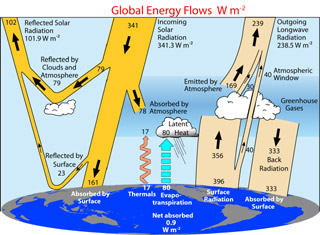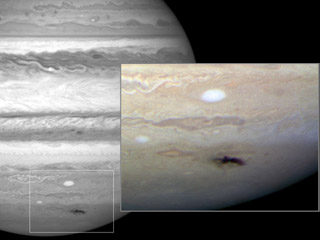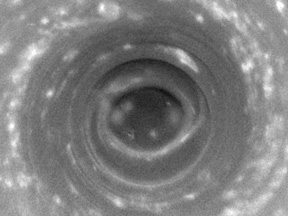This is a thermogram of a house, an IR view of a house. It shows variations in the amount of heat that escapes from a home. Greater heat loss appears in red. Blue indicates areas where little or no heat radiates from the building.
Click on image for full size
Daedalus Enterprises, Inc., Ann Arbor, MI
Infrared (IR) Radiation
Text for this level has not been written yet.
Please see the "Intermediate" text
for this page if you want to learn about this topic.
To get to the "Intermediate" text, click on the blue "Intermediate" button
at the top of the page (between the "Beginner" and "Advanced" buttons).
You might also be interested in:

Light from the Sun shines on Earth. Some of that light reflects off clouds back into space. Some of the light makes it to the ground and warms our planet. The warm ground and oceans give off infrared (IR)
...more
Anthony Wesley is an astronomer in Australia. One night in July 2009, Wesley noticed a dark spot on Jupiter that hadn't been there before. He had discovered the remains of a huge impact on Jupiter! A comet
...more
Astronomers have discovered a strange shape in Saturn's atmosphere. The shape is a hexagon. The hexagon is near Saturn's North Pole. Scientists aren't quite sure why Saturn has the hexagon shape in its
...more
If you wanted to go someplace warm for a vacation, would you choose the South Pole? If you lived on Saturn you might! Saturn's South Pole is the warmest place on the ringed planet. Watch out for the weather,
...more
The Phoebe Ring is one of the rings around the planet Saturn. The Phoebe Ring is much bigger than Saturn's other rings. It is about 100 times larger than the main ring system. The ring was discovered by
...more
The force of magnetism causes material to point along the direction the magnetic force points. Here's another picture of how this works. This picture shows where the magnetic poles of the Earth are to
...more
The Earth has a dipole magnetic field. This is when magnetic field lines point in a direction out of the South Pole and into the North Pole. Planets can also have quadrupoles (4 poles) and octupoles (8-poles).
...more















